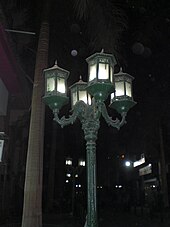Qasr El Nil Street

Qasr El Nil Street, (Arabic: شارع قصر النيل lit. Palace of the Nile street) is a street in downtown Cairo, Egypt. One of the biggest streets in Cairo, with many businesses, restaurants, and an active nightlife.
The vintage urban planning and architecture here are reminiscent of the illustrious period of late 19th and early 20th century European Beaux Arts and Egyptian Islamic MoorishRevival styles. The street and its new building designs were part of creating a new international downtown district. To link to Egypt’s rich Islamic heritage and institutions with the many new foreign enterprises. At the turn of the 20th century in Cairo.
Geography
Qasr El Nil Street extends (east to west): from the Abdeen Palace at Abdeen Square, passes a vibrant business district, Bab El-Lauq Market, and the American University in Cairo Downtown Campus, is joined by Talaat Harb Street and passes through Tahrir Square with the Mogamma building and Egyptian Antiques Museum, and then crosses the Nile River on the Qasr El Nile Bridge, to end on Gezira Island.
History
Isma’il Pasha and Ismailiya era

Ismail Pasha, the ruler of Egypt. belongs to strategically reclaim the East Bank of the Nile opposite Gezira Island, and create a ‘Paris on the Nile.’ The lower area was part of the Nile’s natural pond, marsh, wetland, and riparian zone habitats for millennia, making this an ambitious civil engineering project. The existing 1880s Khairy Pasha palace was higher in the eastern Tahrir Square area, and later was absorbed into the American University in Cairo downtown campus. This urban project’s starting point was building the Egyptian Army. Barracks , which became an important Egyptian and later British government institution. This area was eventually part of the urban district famous as ‘Ismailiya’ and 617 acres (2.50 km2).




Comment (0)